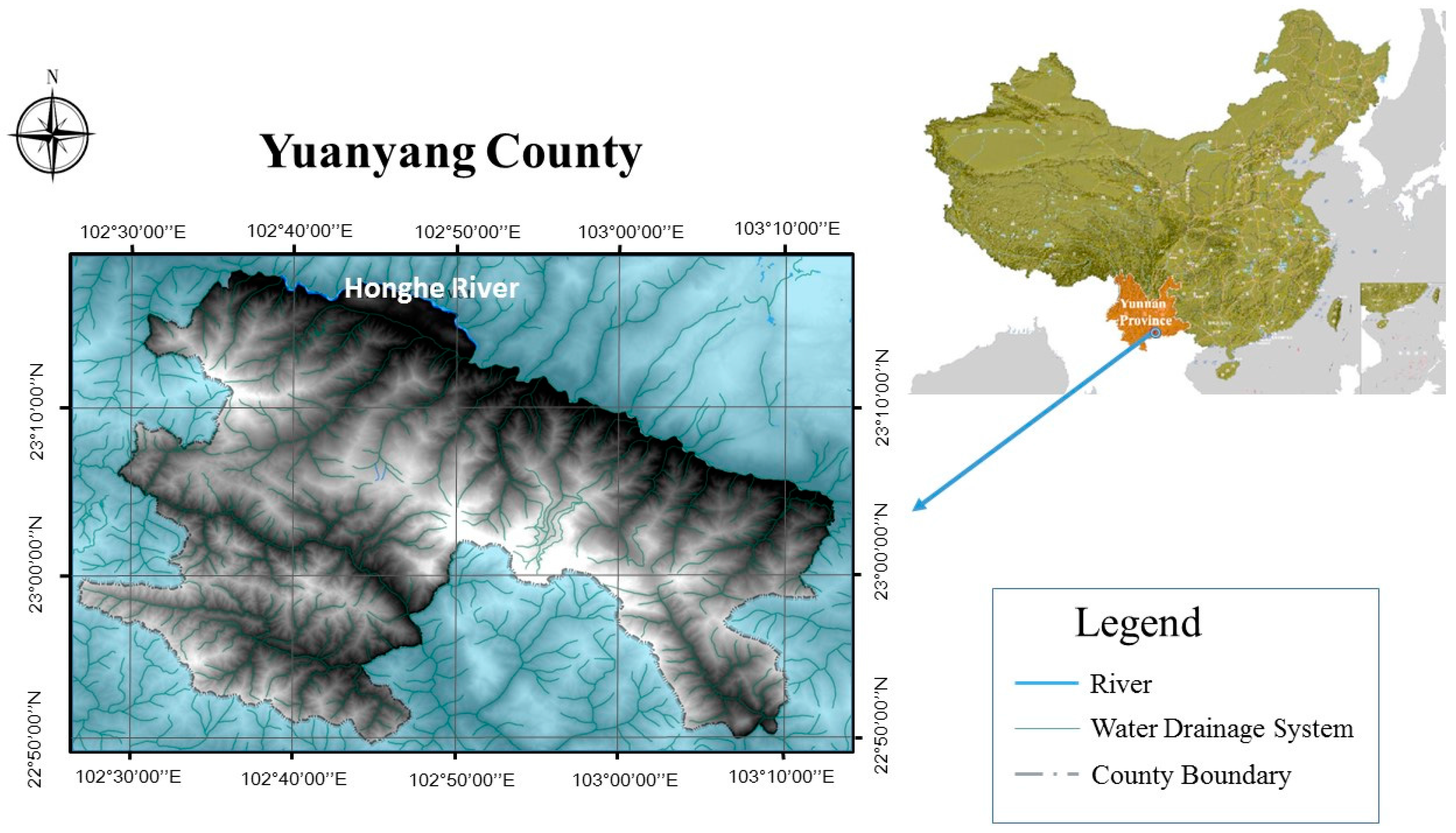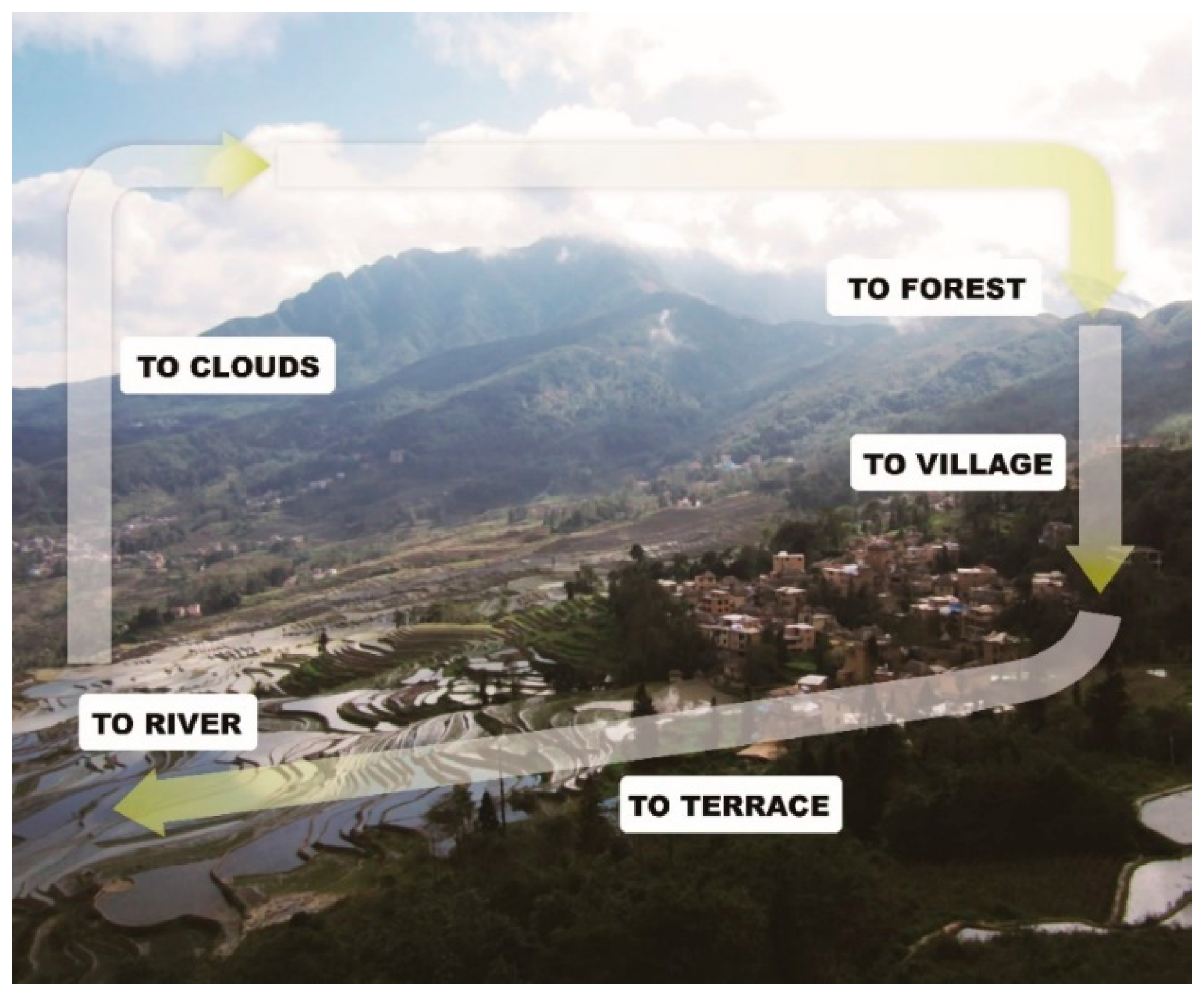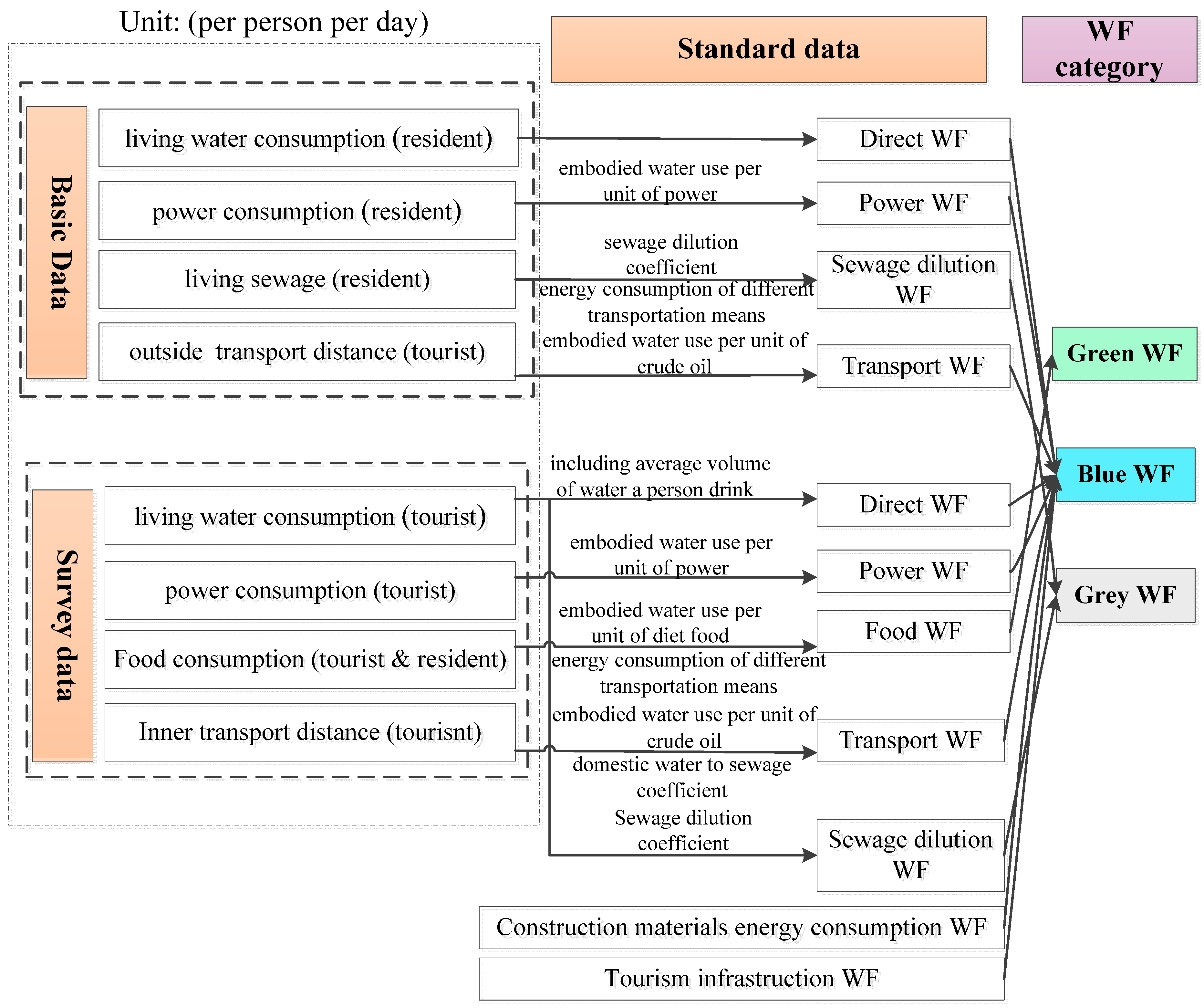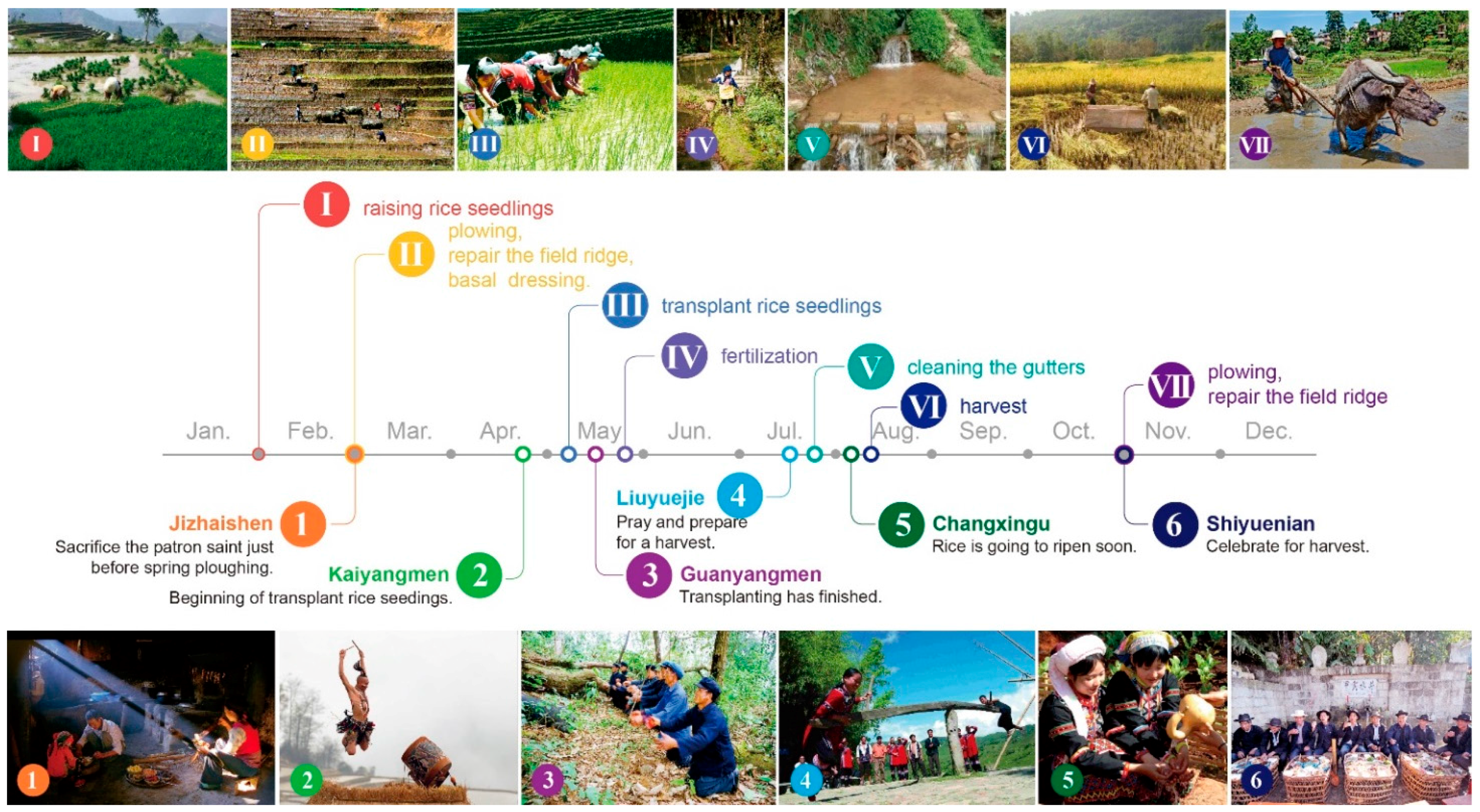Evaluation of Tourism Water Capacity in Agricultural Heritage Sites
Abstract
:1. Introduction
2. Materials and Methods
2.1. Study Area
2.1.1. Profile of the Study Area

2.1.2. Tourism Development at the Heritage Site

2.1.3. Utilization of Water Resources at the Hani Terraces

2.2. Data Sources
2.3. Methods

| Water Use Category | Indicator | Min-Max in L/Guest Night | Estimated Average L/Guest Night |
|---|---|---|---|
| Direct water use | Accommodation | 84–2425 | 350 |
| Activities | 10–875 | 20 | |
| Indirect water use | Infrastructure | 0.2 | 0.2 |
| Fossil fuels for transport | 5–2500 | 130 | |
| Energy use at hotel | 0.3–200 | 75 | |
| Biofuels | 2500 | - | |
| Food | 4500–8000 | 6000 | |
| Other consumption | n.a. | n.a. | |
| Total | Total | 4600–12,000 | 6575 |
2.3.1. Tourism WF at the Heritage Site
2.3.2. Tourism Water Capacity at the Heritage Site
2.3.3. Pressure of Water Resources of the Heritage Site
3. Results and Discussion
3.1. Results
3.1.1. Accommodation Water Footprint

3.1.2. Diet Water Footprint
| Category | Grain (Rice) | Meat | Vegetable | Consumption (kg/person/day) | Diet WF (L/person/day) | |
|---|---|---|---|---|---|---|
| Consumption coefficient ** (kg/person/day) | Urban residents | 0.18 | 0.12 | 0.56 | 0.86 | 1788 |
| Rural residents | 0.43 | 0.10 | 0.45 | 0.98 | 2047.5 | |
| Tourists | 0.14 | 0.10 | 0.14 | 0.38 | 1421 | |
| Water coefficient * (L/kg) | 2000 | 11200 | 150 | - | - | |
3.1.3. Transportation Water Footprint
| Transportation Means | Energy Consumption * (GJ/(Person km)) | Average Distance ** (km/Person) |
|---|---|---|
| Airplane | 0.002 | 83.5 |
| Bus | 0.0007 | 12.2 |
| Car | 0.0018 | 305.6 |
3.1.4. Sewage Dilution Footprint
| Water Use | Water to Sewage Coefficient | Volume of Sewage (L/Person/Day) | Proportion (%) |
|---|---|---|---|
| Bathroom | 0.99 | 91.8 | 74.3% |
| Cooking | 0.50 | 15.0 | 12.1% |
| Laundering | 0.85 | 15.6 | 12.6% |
| Washing cars, cleaning | 0.35 | 1.1 | 0.9% |
| Total | - | 123.5 | 100% |
3.1.5. Total Water Footprint
| Types of Water Footprint | Tourists | Urban Residents | Rural Residents | |
|---|---|---|---|---|
| Blue WF | Accommodation | 159.5 | 116.1 | 77 |
| Transportation | 844.1 | - | - | |
| Meat | 1120 | 1344 | 1120 | |
| Green WF | Grain | 280 | 360 | 860 |
| Vegetable | 21 | 84 | 67.5 | |
| Grey WF | Sewage dilution | 1506.7 | 1065.1 | 773.5 |
| Total Water Footprint | 3931.3 | 2969.2 | 2898 | |
3.1.6. Tourism Water Capacity and Water Use Intensities
3.2. Discussion and Outlook
3.2.1. Comparative Analysis
3.2.2. Water, a Constraint of Tourism Development in the Hani Terraces
3.2.3. Water Management of the Agricultural Heritage Sites

4. Conclusions
Acknowledgments
Author Contributions
Conflicts of Interest
References
- What are GIAHS? Available online: http://www.fao.org/giahs/giahs/en/ (accessed on 24 August 2013).
- Jiao, Y.; Li, X.; Liang, L.; Takeuchi, K.; Okuro, T.; Zhang, D.; Sun, L. Indigenous ecological knowledge and natural resource management in the cultural landscape of China’s Hani Terraces. Ecol. Res. 2012, 27, 247–263. [Google Scholar] [CrossRef]
- Zhu, Y.Y.; Chen, H.R.; Fan, J.H.; Wang, Y.Y.; Li, Y.; Chen, J.B.; Fan, J.X.; Yang, S.S.; Hu, L.P.; Leung, H.; et al. Genetic diversity and disease control in rice. Nature 2000, 406, 718–722. [Google Scholar] [CrossRef] [PubMed]
- Zhu, Y.Y.; Wang, Y.Y.; Chen, H.R.; Lu, B.R. Conserving traditional rice varieties through management for crop diversity. Bioscience 2003, 53, 158–162. [Google Scholar] [CrossRef]
- Liang, L.H. Biodiversity in the Hani Cultural Landscape. Available online: http://ourworld.unu.edu/en/biodiversity-in-the-hani-culturallandscape/ (accessed on 8 November 2015).
- People’s Government of Honghe Hani and Yi Antonomous Perfecture. Proposal for the Globally Important Agricultural Heritage system; People’s Government of Honghe Hani and Yi Antonomous Perfecture: Yunnan, China, 2010.
- Yuan, Z.; Lun, F.; He, L.; Cao, Z.; Min, Q.; Bai, Y.; Liu, M.; Cheng, S.; Li, W.; Fuller, A.M. Exploring the State of Retention of Traditional Ecological Knowledge (TEK) in a Hani Rice Terrace Village, Southwest China. Sustainability 2014, 6, 4497–4513. [Google Scholar] [CrossRef]
- World Wide Fund for Nature (WWF). Freshwater and Tourism in the Mediterranean. 2004. Available online: http://wwf.panda.org/?14217/Freshwater-and-Tourism-inthe-Mediterranean (accessed on 12 November 2014).
- Essex, S.; Kent, M.; Newnham, R. Tourism development in Mallorca. Is water supply a constraint? J. Sustain. Tour. 2004, 12, 4–28. [Google Scholar] [CrossRef]
- Gössling, S.; Peeters, P.; Hall, C.M.; Dubois, G.; Ceron, J.P.; Lehmann, L.; et al. Tourism and water use: Supply, demand, and security. An international review. Tour. Manag. 2012, 33, 1–15. [Google Scholar] [CrossRef]
- WWAP. The United Nations World Water Development Report 4: Managing Water under Uncertainty and Risk. 2012. Available online: http://unesdoc.unesco.org/images/0021/002171/217175E.pdf (accessed on 12 November 2014).
- The World Tourism Organization (UNWTO). UNWTO Tourism Highlights, 2013 ed.; UNWTO: Madrid, Spain, 2013. [Google Scholar]
- United Nations Environment Programme (UNEP). Towards a Green Economy: Pathways to Sustainable Development and Poverty Eradication. 2011. Available online: http://www.unep.org/greeneconomy/Portals/88/documents/ger/GER_synthesis_en.pdf (accessed on 12 November 2014).
- Organisation for Economic Co-operation and Development (OECD). Effective Policies for Growth; In Progress Report; OECD: Paris, France, 2013; p. 24. [Google Scholar]
- Bohdanowicz, P.; Martinac, I. Determinants and benchmarking of resource consumption in hotels—Case study of Hilton International and Scandic in Europe. Energy Build. 2007, 39, 82–95. [Google Scholar] [CrossRef]
- Torres, R. Linkages between tourism and agriculture in Mexico. Tour. Resour. 2003, 30, 546–566. [Google Scholar] [CrossRef]
- Briassoulis, H. Methodological issues: Tourism input-output analysis. Tour. Resour. 1991, 18, 485–495. [Google Scholar] [CrossRef]
- Dwyer, L.; Forsyth, P. Economic measures of tourism yield: What markets to target? Tour. Resour. 2008, 10, 155–168. [Google Scholar] [CrossRef]
- Jones, C.; Munday, M. Evaluating the economic benefits from tourism spending through input-output frameworks: Issues and cases. Local Econ. 2004, 19, 117–133. [Google Scholar] [CrossRef]
- Cazcarro, I.; Hoekstra, A.Y.; Sanchez Choliz, J. The water footprint of tourism in Spain. Tour. Manag. 2014, 40, 90–101. [Google Scholar] [CrossRef]
- Gössling, S. New performance indicators for water management in tourism. Tour. Manag. 2015, 46, 233–244. [Google Scholar] [CrossRef]
- Hadjikakou, M.; Chenoweth, J.; Miller, G. Estimating the direct and indirect water use of tourism in the eastern Mediterranean. J. Environ. Manag. 2013, 114, 548–556. [Google Scholar] [CrossRef] [PubMed]
- Page, S.J.; Essex, S.; Causevic, S. Tourist attitudes towards water use in the developing world: A comparative analysis. Tour. Manag. Perspect. 2014, 10, 57–67. [Google Scholar] [CrossRef]
- Hoekstra, A.Y. Virtual Water Trade, Value of Water Research Report Series No.12; IHE Delft: Delft, The Netherlands, 2003. [Google Scholar]
- Hoekstra, A.Y.; Chapagain, A.K.; Aldaya, M.M.; Mekonnen, M.M. The Water Footprint Assessment Manual: Setting the Global Standard; Earthscan: London, UK, 2011. [Google Scholar]
- Mekonnen, M.; Hoekstra, A. National Water Footprint Accounts: The Green, Blue and Grey Water footprint of Production and Consumption. In Value of Water Research Report Series No. 50; IHE Delft: Delft, The Netherlands, 2011. [Google Scholar]
- Feng, K.; Chapagain, A.K.; Suh, S.; Pfister, S.; Hubacek, K. Comparison of bottom-up and top-down approaches to calculating the water footprints of nations. Econo. Syst. Res. 2011, 23, 371–385. [Google Scholar] [CrossRef]
- Yang, M.; Hens, L.; Wulf, R.; Ou, X. Measuring tourist’s water footprint in a mountain destination of Northwest Yunnan, China. J. Mount. Sci. 2011, 8, 682–693. [Google Scholar] [CrossRef]
- Adachi, S. Agricultural Technologies of Terraced Rice Cultivation in the Ailao Mountains, Yunnan, China. Asian Afr. Area Stud. 2007, 6, 173–196. [Google Scholar] [CrossRef]
- Jiao, Y. Research on Natural and Cultural Landscape Ecology of Hani Terraces, 1st ed.; China Environment Scientific Publisher: Beijing, China, 2009. [Google Scholar]
- Yuanyang County Terraces Management Bureau. Cultural Landscape of Honghe Hani Rice Terraces. Available online: http://whc.unesco.org/en/list/1111 (accessed on 12 November 2014).
- The Statistical Yearbooks of Honghe Hani and Yi Autonomous Prefecture, 2013–2015. Available online: http://www.chinabookshop.net/honghe-hani-autonomous-prefecture-statistical-yearbook-2012-p-16195.html (accessed on 12 November 2014).
- Honghe Prefecture’s Bulletin on Water Resources. Available online: http://wenku.baidu.com/view/67be7a3f376baf1ffc4fad7f.html?from=search (accessed on 12 November 2014).
- Andrew, A. Germany’s water footprint of transport fuels. Appl. Energy 2014, 113, 1746–1751. [Google Scholar] [CrossRef]
- Gössling, S.; Peeters, P.; Ceron, J.P.; Duboisd, G.; Pattersone, T.; Richardson, R.B. The eco-efficiency of tourism. Ecol. Econ. 2005, 54, 417–434. [Google Scholar] [CrossRef]
- Chapagain, A.K.; Hoekstra, A.Y. Water Footprints of Nations. Value of Water Research Report Series: NO.16; IHE: Delft, The Netherlands, 2004. [Google Scholar]
- Almeida, M.C.; Butler, D.; Friedler, E. At-source domestic wastewater quality. Urban Water 1999, 1, 49–55. [Google Scholar] [CrossRef]
- Fortuny, M.; Soler, R.; Cánovas, C.; Sánchez, A. Technical approach for a sustainable tourism development. Case study in the Balearic Islands. J. Clean. Prod. 2008, 16, 860–869. [Google Scholar] [CrossRef]
- Worldwatch Institute. Rising Impacts of Water Use. Available online: http://www.worldwatch.org/topics/consumption/sow/trendsfacts/2004/03/03/ (accessed on 12 November 2014).
- Rosello-Batie, B.; Mola, A.; Cladera, A.; Martinez, V. Energy use, CO2 emissions and waste throughout the life cycle of a sample of hotels in the Balearic Islands. Energy Build. 2010, 42, 547–558. [Google Scholar] [CrossRef]
- Chen, L.; Yan, Y. Agriculture production virtual water consumption and agriculture water resources allocation precedence research. Water Resour. Power 2010, 28, 32–34. [Google Scholar]
- Zhang, Y. China’s Water Resources and Sustainable Development. China Rural Water Hydropower 1998, 5, 3–6. [Google Scholar]
- Han, Y.; Rao, B.; Zhou, B. The preliminary research on water need of ecological environment in Hani terraces. China Rural Water Hydropower 2008, 2, 31–33. [Google Scholar]
- Qi, R.; Geng, Y.; Zhu, Q. Assessment of the Utilization of Regional Water Resources based on the Water Footprint Theory. J. Natl. Resour. 2011, 26, 486–495. [Google Scholar]
- United Nations Educational, Scientific and Cultural Organization (UNESCO). United Nations World Water Development Report 3. Water in a Changing World. 2009. Available online: http://www.unesco.org/water/wwap/wwdr/wwdr3/pdf/WWDR3_Water_in_a_Changing_World.pdf (accessed on 06 August 2014).
- Gössling, S.; Garrod, B.; Aall, C.; Hille, J.; Peeters, P. Food management in tourism. Reducing tourism’s carbon “foodprint”. Tour. Manag. 2011, 32, 534–543. [Google Scholar] [CrossRef]
- Gerbens-Leenes, P.W.; Nonhebel, S. Consumption patterns and their efforts on land require for food. Ecol. Econ. 2002, 42, 185–199. [Google Scholar] [CrossRef]
- Rao, B.; Yang, J.; Zhou, B. The preliminary research of co-ordination between supply and demand. People’s Yangzi River 2009, 40, 28–32. [Google Scholar]
- Nearly Five-Hundred Tourists Visited Hani Terraces during Spring Festival Holidays. Available online: http://asean.yunnan.cn/html/2014–02/14/content_3078460.htm (accessed on 06 April 2015).
- Wen, J.; Li, J. The Preliminary Research of Water Resources Sustainable Utilization Warning Model of Hani Terraced Field. Ecol. Econ. 2006, 2, 61–64. [Google Scholar]
- Massound, M.; Tarhini, A.; Nasr, J. Decentralized approaches to wastewater treatment and management: Applicability in developing countries. J. Environ. Manag. 2009, 90, 652–659. [Google Scholar] [CrossRef] [PubMed]
- Kim, M.; Lee, H.; Kim, M.; Kang, D.; Kim, D.; Kim, Y.; Lee, S. Wastewater retreatment and reuse system for agricultural irrigation in rural villages. Water Sci. Technol. 2014, 70, 1961–1968. [Google Scholar] [CrossRef] [PubMed]
- Sim, R. Food, place and authenticity: Local food and the sustainable tourism experience. J. Sustain. Tour. 2009, 17, 321–336. [Google Scholar] [CrossRef]
© 2015 by the authors; licensee MDPI, Basel, Switzerland. This article is an open access article distributed under the terms and conditions of the Creative Commons Attribution license (http://creativecommons.org/licenses/by/4.0/).
Share and Cite
Tian, M.; Min, Q.; Lun, F.; Yuan, Z.; Fuller, A.M.; Yang, L.; Zhang, Y.; Zhou, J. Evaluation of Tourism Water Capacity in Agricultural Heritage Sites. Sustainability 2015, 7, 15548-15569. https://doi.org/10.3390/su71115548
Tian M, Min Q, Lun F, Yuan Z, Fuller AM, Yang L, Zhang Y, Zhou J. Evaluation of Tourism Water Capacity in Agricultural Heritage Sites. Sustainability. 2015; 7(11):15548-15569. https://doi.org/10.3390/su71115548
Chicago/Turabian StyleTian, Mi, Qingwen Min, Fei Lun, Zheng Yuan, Anthony M. Fuller, Lun Yang, Yongxun Zhang, and Jie Zhou. 2015. "Evaluation of Tourism Water Capacity in Agricultural Heritage Sites" Sustainability 7, no. 11: 15548-15569. https://doi.org/10.3390/su71115548
APA StyleTian, M., Min, Q., Lun, F., Yuan, Z., Fuller, A. M., Yang, L., Zhang, Y., & Zhou, J. (2015). Evaluation of Tourism Water Capacity in Agricultural Heritage Sites. Sustainability, 7(11), 15548-15569. https://doi.org/10.3390/su71115548






